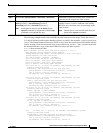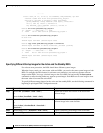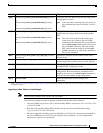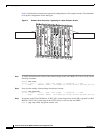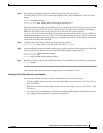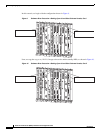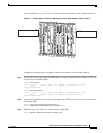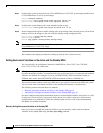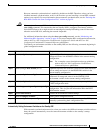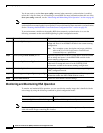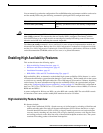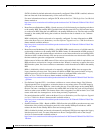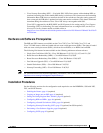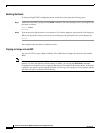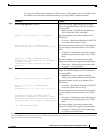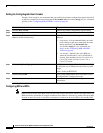
39
Route Switch Processor (RSP8) Installation and Configuration Guide
OL-4920-02
Configuring High System Availability
However, automatic synchronization is enabled by default on the RSP. Therefore, unless you have
disabled automatic synchronization, or this is the first time you are installing a second RSP, a manual
update is not required. For more information about automatic synchronization, see the “Ensuring that
Both RSPs Contain the Same Configuration Files” section on page 28.
Caution When you install a second RSP for the first time, you must immediately configure it using the slave
sync config command. This ensures that the new standby RSP is configured consistently with the
active RSP. Failure to do so might result in an unconfigured standby RSP taking control of the router
when the active RSP fails, rendering the network inoperable.
For additional information about using the slave sync config command, see the “Monitoring and
Maintaining HSA Operation” section on page 40. For more complete HSA configuration information,
refer to the Cisco IOS Configuration Fundamentals Configuration Guide and the Cisco IOS
Configuration Fundamentals Command Reference publications.
To manually set environment variables on the standby RSP, use the following commands beginning in
global configuration mode:
Automatically Setting Environment Variables on the Standby RSP
With automatic synchronization turned on, when you set the active RSP environment variables and save
them, the system automatically saves the same environment variables to the standby’s startup
configuration.
Command Purpose
Step 1
Router(config)# boot system (Optional) Specifies the system image that the router loads at
startup and stores it in the BOOT variable in the current running
configuration.
Note For a complete syntax description and usage guidelines,
refer to the Cisco IOS Configuration Fundamentals
Command Reference publication.
Step 2
Router(config)# boot bootldr file-url (Optional) Specifies the Flash file system and file name that ROM
uses at startup and stores it in the BOOTLDR variable in the
current running configuration
Step 3
Router(config)# boot config file-url (Optional) Specifies the location of the configuration file that the
router uses at startup and stores it in the CONFIG_FILE
environment variable in the current running configuration.
Step 4
Router(config)# end Exits global configuration mode and returns you to privileged
EXEC configuration mode.
Step 5
Router# copy running-config startup-config Saves the current running configuration settings to the startup
configuration. This also puts the information under the RSP’s
ROM monitor control.
Step 6
Router# show bootvar Verifies the environment variable settings.
Step 7
Router# configure terminal Enters global configuration mode.
Step 8
Router(config)# slave sync config Saves the same environment variables to the standby RSP by
manually synchronizing their configuration files.



